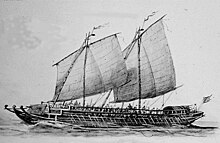Apilan and kota mara

Apilan and kota mara are two Malay nautical terms which refers to the structure on a vessel where the cannon is installed. This term is used especially on Malay ships and boats.
Apilan

Apilan (or ampilan)
Etymology
Apilan is a true Malay word, it was not descended from any word. It is also a standalone word, due to the fact that the syllable is api-lan instead of apil-an.[5]
Kota mara

Kota mara is the
Etymology
The term comes from Malay word kota which in turn comes from the Sanskrit word कोट्ट (kota) which means fort, fortress, castle, fortified house, fortification, works, city, town, or place encircled by walls.[7] The word mara may come from Malay word meaning "appear before", "forward", "come",[5] "moved to the front", "forward", and "advanced".[8] Thus it can be interpreted as "breastwork before a cannon" or "breastwork at the front". According to the Great Indonesian Dictionary (KBBI), kota mara means (1) Wall on a ship to protect men mounting the cannon (2) Terrace or wall over a castle which a cannon is mounted.[5] According to H. Warington Smyth, kota mara means transverse deck bulkhead at stem and stern (of a ship).[9] Benteng itself means fort, battery, or redoubt.[4]
Example on records

Singapore resident
H. H. Frese description of personal ship of the Sultan of Riau from 1883:[11]
This fast and impressive ship is heavily armed to fend off pirates, a real danger at that time. Two heavy muzzle-loading brass guns mounted on carriages are placed on the foredeck pointing forward. A heavy shield, or apilan, for the protection of the gunners, is constructed of horizontal beams for which fresh wood had to be used to prevent dangerous splintering when hit by a ball or bullet.
— The Mariner's Mirror
Lieutenant T.J. Newbold record about the Malay pirate prahu:[3]
The prahus used by Malay pirates are from eight to ten tons burthen, extremely well manned and remarkably fast, particularly with the paddles commonly used. They are generally armed with swivels on their bows, centre, and stern, of small calibre, but long range. When preparing to attack, strong bulwarks of wood called Apilans are erected, behind which the crew ensconce themselves, fighting with their long guns until their prey is disabled; or till the gong sound the signal for boarding.
— Journal of the Asiatic Society of Bengal, Volume 5
See also
- Jong – Javanese sailing ship
- Malangbang – Indonesian medieval sailing ship
- Kotta mara – Floating fort from Borneo
- Lanong – Type of warship from the Philippines
- Bajak – Dayak prahu with lug sail
- Salisipan – Narrow war canoe from Philippines
References
- ^ Crawfurd, John (1856). A Descriptive Dictionary of the Indian Islands and Adjacent Countries. Bradbury and Evans.
- ^ a b Wilkinson, Richard James (1908). An Abridged Malay-English Dictionary (Romanised). Kuala Lumpur: F.M.S Government Press.
- ^ a b Newbold, T.J. (1836). "Note on the States of Perak, Srimenanti, and other States in the Malay Peninsula". Journal of the Asiatic Society of Bengal. 5 – via Google Books.
- ^ a b c Wilkinson, Richard James (1901). A Malay-English dictionary. Hongkong: Kelly & Walsh, limited.
 This article incorporates text from this source, which is in the public domain.
This article incorporates text from this source, which is in the public domain.
- ^ a b c Departemen Pendidikan Nasional (2008). Kamus Besar Bahasa Indonesia Pusat Bahasa Edisi Keempat. Jakarta: PT Gramedia Pustaka Utama.
- ^ Liebner, Horst. "2016 Gambar Dan Tabel Perahu MSI short1.pdf" (in Indonesian).
{{cite journal}}: Cite journal requires|journal=(help) - ISBN 9781501718946.
- ^ "MARA - Definition and synonyms of mara in the Malay dictionary". educalingo.com. Retrieved 2020-01-19.
- ^ Smyth, H. Warington (May 16, 1902). "Boats and Boat Building in the Malay Peninsula". Journal of the Society of Arts. 50: 570–588 – via JSTOR.
- ^ Murfett, Malcolm H. (2011). Between 2 Oceans (2nd Edn): A Military History of Singapore from 1275 to 1971. Marshall Cavendish International Asia Pte Ltd.
- ^ H. H. Frese. (1956). Small Craft in the Rijksmuseum voor Volkenkunde, Leiden. The Mariner's Mirror. 42 : 2, 101-112.





